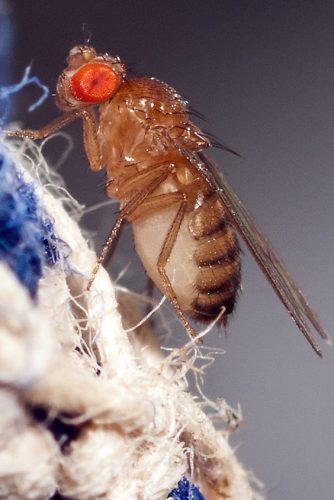Image courtesy of Wikimedia Commons
In the last century, American life expectancy has more than doubled from forty-seven years in 1900 to seventy-eight in 2019. With antibiotics and vaccines, child mortality rates have sharply dropped alongside mortality rates at every age. But, as lifespans have increased, so have the average years lived with disability. Research has turned towards age-related diseases, with heart disease, cancer, Alzheimer’s disease, and diabetes replacing infectious diseases as the most common causes of death. In the Partridge Lab at University College London, scientists discovered a combination of three drugs that increases the lifespan of fruit flies by almost fifty percent, indicating that perhaps prescribing multiple drugs targeting different aspects of aging is essential for improving late-stage quality of life.
Combination therapies are routinely used to attack complicated diseases from as many angles as possible, thus increasing the chance of a cure and decreasing the chance of eventual drug resistance. These therapies have been applied to a spectrum of diseases, including HIV, cancer, and, recently, cardiovascular disease, To delay aging, the researchers combined three inhibitors all acting on different pathways associated with aging: trametinib, lithium, and rapamycin. Trametinib is normally used to treat melanoma, a form of cancer, by inhibiting overactive enzymes driving uncontrolled cell growth. Lithium is a chemical inhibitor of a molecule associated with cancer, inflammation, Type II diabetes, and Alzheimer’s disease. Rapamycin is used to prevent kidney transplant rejection by inhibiting the activation of immune cells. Each drug had been previously associated with extended fruit fly lifespan by the Partridge lab, but this is the first time the three drugs were tested together.
To administer the drugs to the fruit flies, researchers fed a sugar-yeast-agar medium to female flies two days after hatching. Researchers then measured the number of dead and alive fruit flies every day until all flies had died. Used individually, each drug in the combination extended lifespan by an average of eleven percent. Used in pairs, the drugs extended lifespan by an average of thirty percent. Amazingly, the three-drug combination increased the median fruit fly lifespan by forty-eight percent.
One possible explanation for the life-prolonging properties of the combination is that the drugs reduce the damaging side effects of each other. Jorge Castillo-Quan, one of the researchers, first realized the possibility of the combination in 2014 when he found that lithium could block fat accumulation in sugary diets and thought that it could also block fat accumulation from rapamycin use as well. Indeed, when combined with rapamycin, lithium reverses any effects on metabolism; feeding frequency, food intake, and drug intake were unaltered in the treatment group versus the control group. Dampening the effects of rapamycin on metabolism allows for the drug to be used more safely.
With metabolism unaltered, the question of how the therapy increases lifespan remains. Life is a balancing act of growth, reproduction, and maintenance. If an organism spends more of its limited resources on growth or reproduction, it will have less left over to dedicate towards maintenance of health into old age. Thus, researchers proposed that perhaps a decrease in resources devoted to reproduction could explain the increased lifespan. However, at the concentrations used, only trametinib decreases reproductive efficiency (as measured by the number of eggs laid daily), so this theory fails to explain why the other two drugs also increase lifespan. Although the targets of the individual drugs do not seem to overlap, the drug combination could activate other unknown mechanisms. “This will be difficult to test because it is likely the combined effect of impacts on different tissues but is very important to address in the near future,” Castillo-Quan said.
Promising results in fruit flies raise the question of how relevant these data are to age-related disease in humans. While genetic and dietary interventions have also been shown to slow aging in laboratory animals in the past, this joint pharmaceutical therapy is particularly promising because of its straightforward optimization and ease of implementation. All of the aforementioned drugs are already approved for and being used in humans for other conditions.
Nowadays, elderly patients regularly take multiple drugs to treat different conditions–perhaps one pill for diabetes, another for high blood pressure, and one to lower cholesterol for example. “A cocktail or polypill for aging is hence only logical, even more so when we know that cells and tissues adapt to drugs over time and drugs have side effects other drugs can counteract,” Castillo-Quan explained. Aging, like most bodily processes, is exceedingly complex. It is not one disease but rather a collection of processes. It makes sense that our most effective treatment would be complex too.

